Experience the diversity of Shenzhen at once, highly recommended for sisters who come to Nanshan on business trips
🌈Citywalk route: Mixc World👉🏻Shenzhen Bay Park👉🏻Shekou Old Street👉🏻Sea World👉🏻Happy Harbor
1⃣️📍First stop Mixc World
A special shopping mall with a block + mall, with many beauties. Take the elevator to the 5th floor, exit the middle passage between Broadway Cinematheque and mstand, the classic camera position of Shenzhen Manhattan, a must-see. Go to the 4th floor to buy a cup of grandma's handmade, longan ice is the signature. After watching🚴🏻 ride a bike to the next stop
2⃣️📍Second stop Shenzhen Bay Park
Shenzhen Bay is the embodiment of romance. Cycling all the way, riding towards Mangrove Bay, overlooking Hong Kong Island and the Bay Bridge, with Nanshan CBD buildings behind, the sunset is golden, the sea is sprinkled with broken diamonds, and the wet and cool sea breeze passes by my ears. It is hard to describe my mood at this moment. I want to be a happy bird, and I stay for a long time and don’t want to leave. Ride to Mangrove Bay MTR station, take the subway to the old street to find food.
3⃣️📍The third stop is Shekou Old Street.
Exit from Dongjiaokou MTR Station Exit A, follow the order below to eat, the route is very smooth. ✔️Xiao Liu Fried Tofu: Dry mixed tofu is so delicious, highly recommended! The sauce is very soulful, kimchi is greasy, and a small portion is enough. ✔️Foshan Master Huang’s Sugar Water: Ginger milk is the signature, made in 3 minutes, spicy and sweet, especially love it. ✔️Bai Caotang: Red bean double skin milk is delicious, the ingredients are so much that they are about to overflow, especially ✔️Hong Kong Dragon Phoenix Bread: Pineapple buns are delicious! ✔️Jiahua Snacks: Rice dumplings and clay pot rice are the signature dishes. Each customer gets one portion. They look delicious, but I couldn’t eat them anymore.
✔️Huang Li Ji Pig Intestine Rolls: When I went there, the pig intestine rolls were sold out. I ordered green bean soup + Yangjiang lao fen, which were also very delicious.
Every store in Shekou is quite old-fashioned. The environment is simple, but the human touch is full. It is very worth coming.
4⃣️📍The fourth stop is Sea World.
After eating and drinking, I went to digest the food and rode a bike to Sea World.
First, I went to the Huanchuan Square to see the Minghua Ship. For the first time, I was shocked to see a huge ship in the mall. The business district was very lively and the night view was beautiful.
Then I walked to the Sea World Culture and Art Center, which is another quiet and chill world. Sit on the steps and listen to the live performance. The singer sings not to talk. Silently blow the sea breeze. Very relaxed, with a lot of thoughts
5⃣️📍The fifth stop is Happy Harbor
If there is still time, the last leg, take the subway🚇 to Happy Harbor
Go to see the light of the Bay Area. The Ferris wheel is very romantic from any angle. Take a walk on the beach. The night after get off work is quiet and beautiful
⭐Shenzhen's night view is very beautiful, the architecture is beautiful, the lights are beautiful, the sea view is beautiful, and any shopping mall is adjacent to the beach. I envy it very much as a drifter in Beijing. I can't help but feel what troubles I have when I blow the sea breeze and daze
⭐Another thing I envy is Shenzhen's nightlife. The small streets at 10 o'clock in the evening are bustling, and there are so many varieties of midnight snacks that I can't finish them in a month. I have to sigh that this is life
⭐The above itinerary, from 15:00 to 21:00, lasted 6 hours, and the spirit was fully recharged. I hope everyone can feel the charm of Shenzhen in a limited time
Sign in to join the conversation
Sign InNo comments yet. Be the first to share your thoughts!
Xiamen City, abbreviated as "Xia" or "Lu", is a prefecture-level city, a sub-provincial city, a separately planned city, and a Type I large city under the jurisdiction of Fujian Province, China. [164] [198] It is located on the southeastern coast of Fujian Province [186]. It faces the Big and Small Kinmen Islands to the east and Longhai District of Zhangzhou City to the south. It borders Nan'an City of Quanzhou City, Anxi County of Quanzhou City, Changtai District of Zhangzhou City, and Longhai District of Zhangzhou City by land. [207] It has a total area of 1,700.61 square kilometers and the language used is the Minnan dialect. [123] As of the end of 2023, Xiamen City has 6 districts under its jurisdiction; by the end of 2024, the permanent population of Xiamen City is 5.35 million [225]; the Municipal People's Government is located at No. 61 Hubin North Road, Siming District. [204] The territory of Xiamen City consists of the mainland area along Xiamen Bay in the southeast of Fujian Province, as well as the islands of Xiamen Island, Gulangyu Island, and Xiamen Bay. The terrain slopes from northwest to southeast, and is mainly composed of coastal plains, terraces, and hills. It has a subtropical marine monsoon climate, with mild and rainy weather, no severe cold in winter, and no scorching heat in summer. [205] In ancient times, Xiamen Island was a habitat for egrets, so it was also called "Egret Island". During the Western Jin Dynasty, Tong'an County was established. In the 27th year of Hongwu in the Ming Dynasty (1394), Xiamen City was built. In 1935, Xiamen City was established. In 1980, Xiamen Special Economic Zone was established. In 1988, it became a separately planned city. In 1994, it was promoted to a sub-provincial city.
Sanya City is a prefecture-level city under the jurisdiction of Hainan Province. It is located at the southernmost tip of Hainan Island and is known for its tropical climate, beautiful beaches, and luxury resorts. Sanya is one of China's most popular tourist destinations and is often called the "Hawaii of China".
Leshan City (Sichuan dialect pinyin: No2san1; local pronunciation: [nʊʔ3sã55]), formerly known as Jiazhou and Jiading, is a prefecture-level city under the jurisdiction of Sichuan Province, People's Republic of China, located in the south-central part of Sichuan Province. The city borders Zigong City and Yibin City to the east, Liangshan Prefecture to the south, Ya'an City to the west, and Meishan City to the north. It is located in the southwest of the Sichuan Basin, with the Chengdu Plain in the north, the hilly area of central Sichuan in the east, and the Xiaoliangshan Mountains in the southwest. The terrain is high in the southwest and low in the northeast. The Minjiang River runs from north to south, merges with the Dadu River and the Qingyi River in the urban area, and then flows out of the city to the southeast. The total area of the city is 12,720 square kilometers, with a population of 3.2605 million. The Municipal People's Government is located in the Shizhong District. Leshan is a national historical and cultural city and an excellent tourist city in China. The famous Leshan Giant Buddha is located on the south side of Lingyun Temple on the east bank of the Minjiang River. Mount Emei, one of the four famous Buddhist mountains in China, is located in the northwest of the city.
Tianjin City, referred to as "Jin", also known as Jingu and Jinmen, is a municipality directly under the Central Government of the People's Republic of China, a national central city, and a megacity [222]. It is located in the North China region of the People's Republic of China, in the lower reaches of the Haihe River Basin, bordering the Bohai Sea to the east, Yanshan Mountain to the north, the capital Beijing to the west, and the rest of the city is adjacent to Hebei Province. As of October 2023, Tianjin has 16 districts under its jurisdiction [93], with a total area of 11,966.45 square kilometers. As of the end of 2024, Tianjin has a permanent population of 13.64 million. [268] Tianjin is located in the northeast of the North China Plain and has a warm temperate semi-humid monsoon climate with distinct four seasons. Tianjin has been prosperous since ancient times due to the canal transportation. After the middle of the Tang Dynasty, it became a land and water port for transporting grain and silk from the south to the north. In the Jin Dynasty, Zhigu Fort was established at the Sanchakou area where the North-South Grand Canal and the Haihe River meet. This was the earliest establishment in Tianjin. In the Yuan Dynasty, "Haijin Town" was established, which was a military stronghold and a grain transportation center. In the second year of the Yongle reign of the Ming Dynasty (1404), the city was officially built. On March 7, the third year of the Yongzheng reign, Tianjin Wei was promoted to Tianjin Prefecture, which belonged to Hejian Prefecture [243]. In the ninth year of the Yongzheng reign, Tianjin Prefecture was promoted to Tianjin Prefecture, which had six counties and one prefecture under its jurisdiction. After 1912, Tianjin Prefecture was abolished [234]. It is the only city in ancient China with a definite record of its founding time [231]. Tianjin is an important central city in China approved by the State Council, a national historical and cultural city, a modern marine city, an international comprehensive transportation hub city, a national advanced manufacturing R&D base, a northern international shipping core area, and a financial innovation operation demonstration area [1] [230]. Tianjin is a major node of the China-Mongolia-Russia Economic Corridor, a strategic fulcrum of the Maritime Silk Road, a meeting point of the Belt and Road Initiative, and the nearest eastern starting point of the Eurasian Continental Bridge. It is an important seaport for neighboring landlocked countries, the largest port city in northern China, and a key location and gateway to protect the capital. [257]
Jieyang City is a prefecture-level city under the jurisdiction of Guangdong Province and one of the four cities in the Chaoshan region. It is a famous hometown of overseas Chinese, located in the southeastern part of Guangdong Province, at the center of the geographical axis between the Guangdong-Hong Kong-Macao Greater Bay Area and the Haixi Economic Zone.
Hefei City, abbreviated as "Lu" or "He", was formerly known as Luzhou, Luyang, and Hefei [1]. It is a prefecture-level city, provincial capital, and megacity under the jurisdiction of Anhui Province [93-94]. It is located in the eastern part of China, the central part of Anhui Province, and the western wing of the Yangtze River Delta. It surrounds Chaohu Lake and has a total area of 11,445 square kilometers [101]. Jianghuai Mandarin is spoken. As of March 2025, Hefei City has jurisdiction over 4 districts, 4 counties, and administers 1 county-level city. As of the end of 2024, the permanent population of Hefei City is 10.02 million. [122] Hefei City has a subtropical monsoon humid climate, with obvious monsoons, distinct four seasons, mild climate, and moderate rainfall; there are three types of landforms in the territory: hilly land, low mountain residual hills, and low-lying plains. [119] Hefei has been established as a county since the Qin Dynasty. In the third year of the Kaihuang reign of the Sui Dynasty (583), Hefei County was restored. From then until the end of the Qing Dynasty, Hefei was the seat of Luzhou, prefecture, and road. In the first year of the Republic of China (1912), Luzhou Prefecture was abolished and Hefei County was directly under the jurisdiction of Anhui Province. In September 1945, the capital of Anhui Province was moved to Hefei. In 1952, Anhui Province was restored and Hefei became the capital of Anhui Province in New China. [16] [111] Hefei is one of the important birthplaces of Chinese civilization. It is named after the Dongfei River and the Nanfei River both originate here. It is an important administrative center, commercial port and military town in the Jianghuai region. It is known as "the right collar and throat of the Huai River, the lips and teeth of the south of the Yangtze River", "the first county of the Jianghuai River, the key point of Wu and Chu", "the former site of the Three Kingdoms, the hometown of Bao Zheng, and the cradle of the Huai Army".
The central area of Beijing, with many historical sites and cultural attractions. Dongcheng District, under the jurisdiction of Beijing, is located in the eastern center of Beijing. It borders Chaoyang District to the east and north, Fengtai District to the south, and Xicheng District to the west. It lies between 116°22′17″-116°26′46″ east longitude and 39°51′26″-39°58′22″ north latitude. The maximum distance from east to west is 5.2 kilometers, the maximum distance from north to south is 13 kilometers, and the total area is 41.84 square kilometers [57] [60]. As of October 2022, Dongcheng District has 17 sub-districts under its jurisdiction [34]. As of the end of 2023, Dongcheng District has a permanent population of 703,000. [46] Dongcheng District is the area with the most cultural relics and historical sites in Beijing. There are 16 national-level cultural relics protection sites in the district, accounting for 37% of Beijing; 60 municipal-level cultural relics protection sites, accounting for 24% of the city; and 57 district-level cultural relics protection sites. Among the famous 16 new Beijing scenes, the "Tian'an Beautiful Sun" and "Forbidden City Sunset", the ancient and mysterious Lama Temple, the Imperial Academy, the highest institution of learning in the Yuan, Ming and Qing dynasties, the "left ancestor and right community" Taimiao and Sheji Altar, the Beijing Ancient Observatory that explores the mysteries of the sky, the bell and drum tower of the Mingjin Leigu Time-telling Platform, the Wen Tianxiang Temple with its righteous spirit, and the Peking University Red Building have long been famous at home and abroad. In addition, there are a number of former residences of celebrities such as Mao Zedong, Mao Dun, Lao She, and Soong Ching Ling. In addition, there are Beijing residential courtyards. [60] In 2024, the GDP of Dongcheng District will increase by about 4.5% year-on-year; the district-level general public budget revenue will reach 19.5 billion yuan; the fixed asset investment will reach 27 billion yuan; the per capita disposable income of residents will increase by about 3% year-on-year; and the energy consumption per unit of GDP will decrease by about 5%. [76]
Dali City (Bai: Dallit sil) is a county-level city in Dali Bai Autonomous Prefecture, Yunnan Province, People's Republic of China, and is also the capital of Dali Prefecture. It is located in the western part of Yunnan Province, China, on the Yunnan-Guizhou Plateau, at the foot of Cangshan Mountain, and on the shore of Erhai Lake. The city covers an area of 1,739 square kilometers, with a total population of 771,100 in 2020. The Municipal People's Government is located in Haidong Town. Dali City is a national historical and cultural city[6], an excellent tourist city in China, a national garden city[7], and a national comprehensive tourism demonstration area[8]. In ancient times, it was the capital of Nanzhao Kingdom and Dali Kingdom successively. It is one of the earliest developed regions in Yunnan Province and has served as the political, economic and cultural center of Yunnan for more than 500 years.
【About attractions】  1️⃣Observatory: Free, gah "Shenzhen Observatory" reservations are required in advance, closed on Mondays, the plank road to the sea, one of the eight most beautiful coastlines in China, very film-worthy 2️⃣Yangmeikeng: Far from the city, it is the filming location of the movie "The Mermaid", with a beautiful coastline and clear and clean sea water 3️⃣Window of the World: Tickets are 220r, opening hours are 9:00-22:30, a miniature landscape theme park that brings together famous attractions from all over the world 4️⃣Dameisha: Free, open all day, a famous seaside bathing beach, with fine sand on the beach 5️⃣Happy Coast: Free entry, some projects require separate charges, a seaside leisure area integrating catering, entertainment and shopping, with beautiful night views 6️⃣Shenzhen Bay Park: Free, open all day, walking in the park with the sea breeze, very pleasant, and also a good place for outdoor activities and parent-child tours 7️⃣Xianhu Botanical Garden: Gate Tickets are 15r, opening hours are 6:00-21:30, there are many kinds of plants, and there are cultural landscapes such as Hongfa Temple 8️⃣ Huaqiangbei: open all day, directly connected by Metro Line 7, not only a paradise for electronic products, but also many special objects, worth visiting 9️⃣ Mixc World: open all day, check in the famous Manhattan camera, high-rise buildings, feel the prosperity of Shenzhen 1️⃣0️⃣ Zhongying Street: open all day, half of Shenzhen, one Half Hong Kong, selling all kinds of duty-free goods, saving time and effort compared to going through customs to Hong Kong 1️⃣1️⃣Sea World: free and open, directly accessible by Metro Line 2, with the "Ming Hua Lun" as the core landscape, unique and a great place to take photos and check in, 1️⃣2️⃣Dongmen Old Street: Foodie paradise, rich variety of snacks [Specific itinerary] # day1: 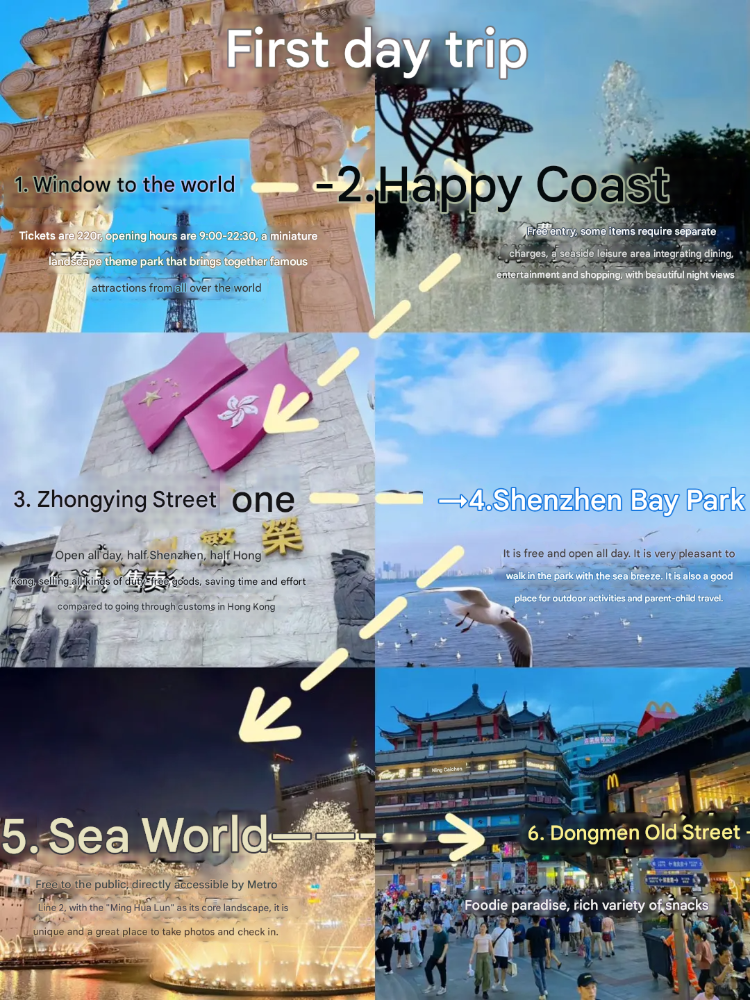 Window of the World➡️Happy Coast➡️Central and British Street➡️Shenzhen Bay Park➡️Sea World➡️ Dongmen Old Street # day2:  Huaqiangbei➡️Vanxiang Tiandi➡️Xianhu Botanical Garden➡️Dameisha➡️Yangmeikeng➡️Observatory [About transportation] ✈️: Shenzhen Bao'an Airport, many routes 🚄: 7 high-speed railway stations, Shenzhen Station, Shenzhen North Station, Futian Station are recommended 🚇The subway is the first choice for urban transportation, many attractions can be directly reached, convenient and cost-effective [About food] Guangdong rice rolls, Cantonese cuisine (suckling pigeon, egg yolk barbecued pork, marinated platter, roast goose), Cantonese breakfast (chicken feet, red rice sausage, durian pastry, shrimp dumplings) clay pot rice, sweet soup Must-eat restaurants: Chao Bazhen, Shanhetian, Fenghao BBQ, Uncle Zhong's glutinous rice cake, Bashu style (Vanxiang Tiandi store), Sister Douhua Peng Restaurant (OCT store)
Share a Shenzhen seaside walking route with very blue water! There are beaches! There are coconut trees! Very photogenic 🌊 ✅Route: 💡The symbols between the locations represent the way to get there 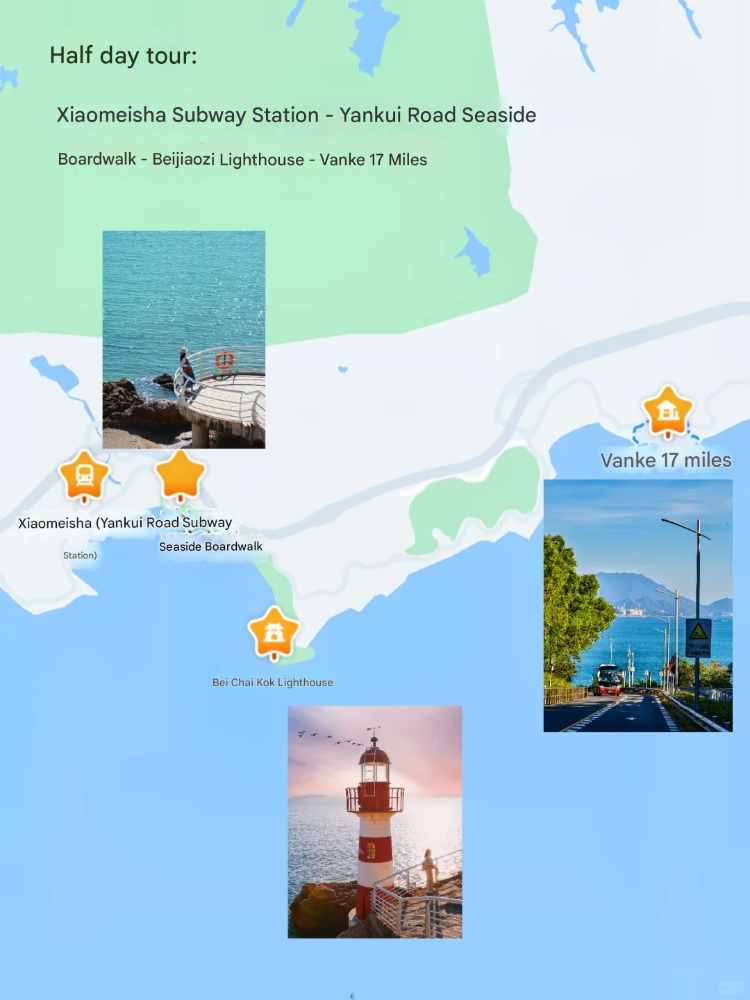 ▪️One-day tour route First take Metro Line 2 to Haishan Station, then check in one by one: Haishan Seaview Park 🚇 Dameisha 🚇 Xiaomeisha Seaside Boardwalk 🚶 Beijiaozi Lighthouse 🚖 Vanke 17 Miles 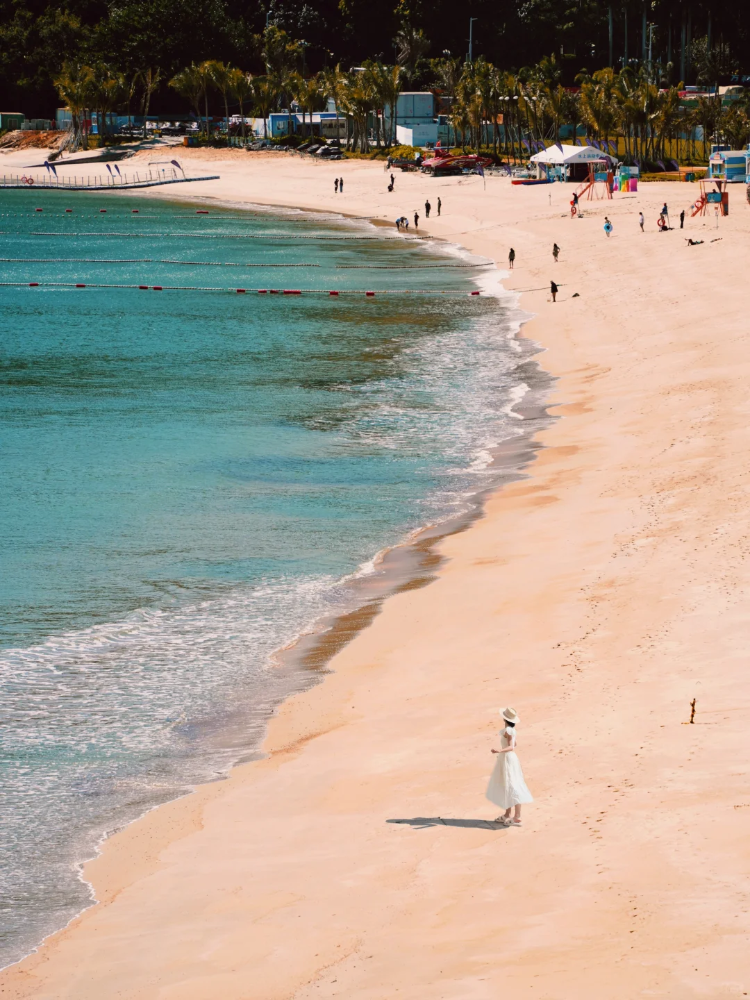 ▪️Half-day tour route Take Metro Line 2 to Xiaomeisha Station, then check in one by one: Xiaomeisha Subway Station 🚶 Xiaomeisha Seaside Boardwalk 🚶 Beijiaozi Lighthouse 🚖 Vanke 17 Miles ✅Check-in points: 📍Haishan Seaview Park: 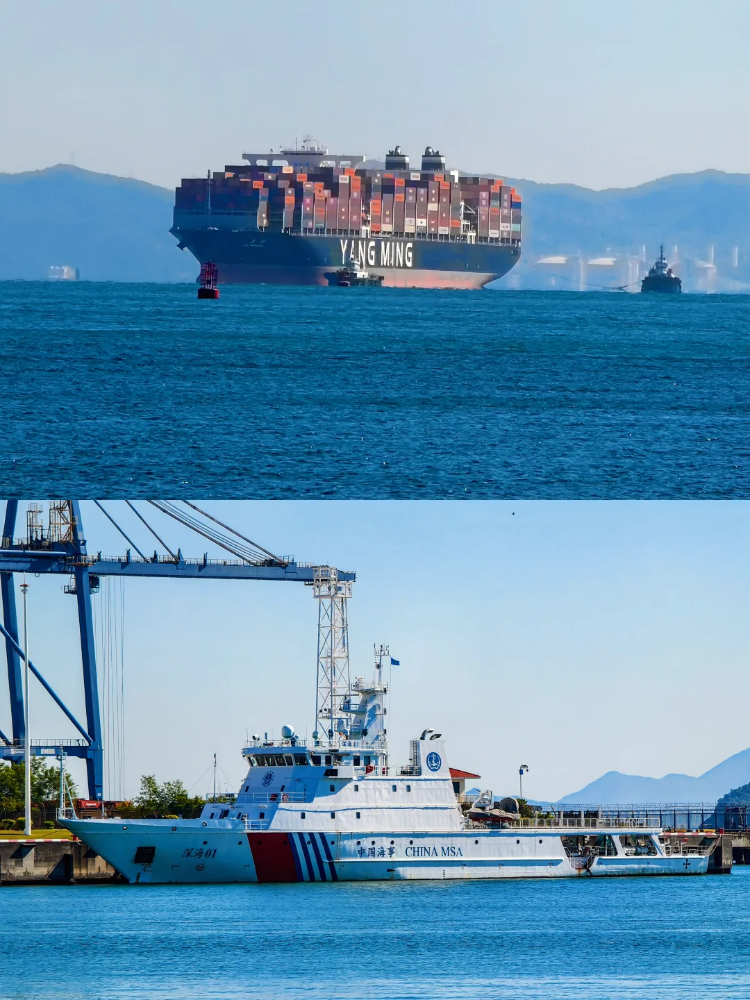 Walk 500 meters from Exit B of Haishan Station, you can take pictures of flowers, big ships, seagulls, and the sea 📍Dameisha : 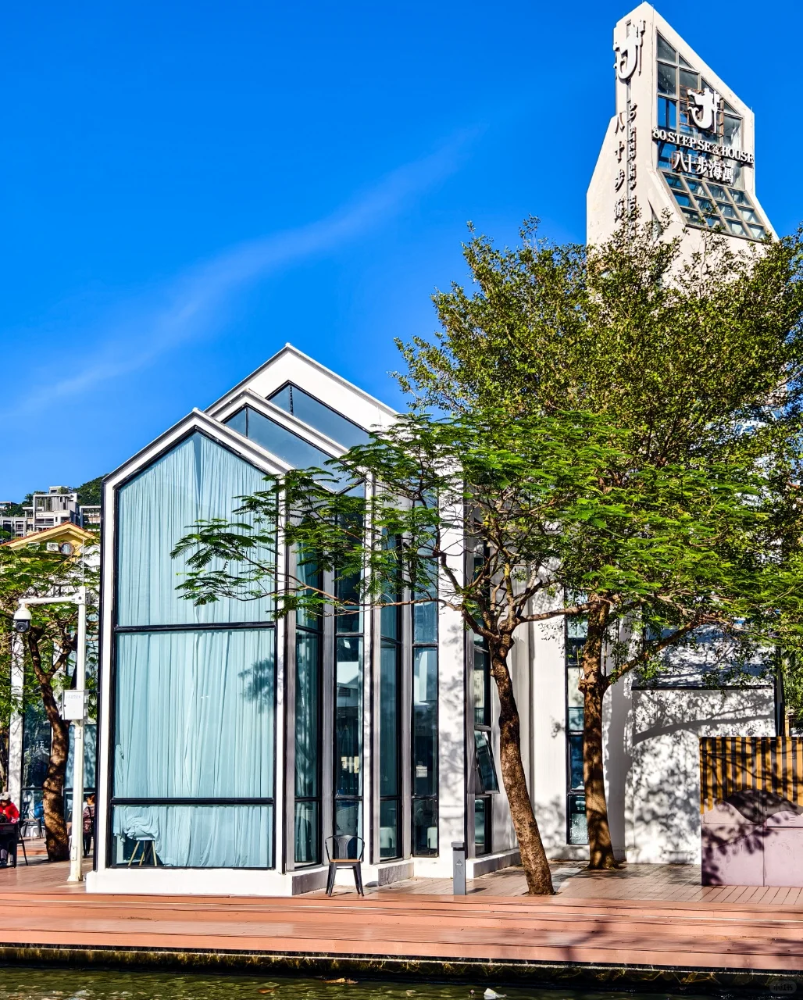 There is a 🆓 beach just outside Dameisha Station, and there is a popular library (Habitat Library) 500 meters away 📍Xiaomeisha Seaside Boardwalk (P3,4,5,11,12): After exiting Xiaomeisha Metro, follow the walking navigation "Yankui Road Seaside Boardwalk", the white boardwalk next to the blue sea 📍Beijiaozi Lighthouse (P6): Walk to the beach from the seaside boardwalk, the scenery on the way is also beautiful 📍Vanke 17 Miles (P1): Arrived 🚖3km from the lighthouse, you can take pictures of the blue sea at the end of the road!
📍Shenzhen Observatory-Dapeng  ✅The most beautiful coastline recommended by National Geographic, half plank road, half sea 🚗: Drive to No. 4 Beach of Xichong Beach and transfer to a minibus to the top of the mountain 🎫: Free 🕒: 09:00-12:00 14:30-17:30 Closed on Mondays 📍Judiaosha-Dapeng New District  ✅Shenzhen's Maldives, with a beautiful glass sea! 🚗: Bus M27 Judiaosha Station 🎫: Partially free 🕒: 24h 📍Luzui Villa-Dapeng New District  ✅The filming location of the movie "The Mermaid", with valleys, cliffs, cliffs, reefs, and beaches 🚗: Take M274 to Yangmeikeng Station-take a sightseeing bus (13.8r) or a speedboat (30r) to Luzui Villa 🎫: Free 🕒: 6:00-18:00 📍Yougan Bay-Longgang District ✅Yougan Bay, located on the Nan'ao Peninsula, faces the sea. It is a natural deep-water bay, a super niche glass sea, and comes to It feels like being in Hawaii here, with a sparkling glass sea 🚗: Take E11 to Dapeng Moon Bay, then take a taxi to Nan'ao Yougan Bay Royal Resort Hotel 🎫: Free 🕒: 8:00-18:30 📍Yunhai Square-Yantian District ✅Shenzhen version of the Sky City 🚗: Sanzhoutang Reservoir Yunhai Park Observation Deck (Metro Line 8 Haishan Station Exit B2, take the Yunhai Special Bus) 🎫: Free 🕒: 8:30-18:00 (You can enter the Yunhai Square Library) 📍Shenzhen Bay Park-Nanshan District Highlights: Siberian seagulls have flown back to Shenzhen! ! Orange sunset at the seaside with coconut trees 🚗: Exit D2 of Shenzhen Bay Park, Line 9 🎫: Free 🕒: 6:00-23:00 📍Shenzhen Happy Harbor-Bao'an District ✅Shenzhen's new landmark, with the popular "Light of the Bay Area" Ferris wheel, overlooking the beauty of the entire Bay Area 🚗: Exit B2 of Linhai Station, Line 5 🎫: Free 🕒: 24h 📍Qianhai Stone Park-Nanshan District ✅Check in at the giant milk dragon, the Ferris wheel lights up at night and is also very beautiful, suitable for picnics and camping 🚗 : Exit E of Guiwan Station on Metro Line 5 🎫: Free 🕒: 24h 📍Sea World-Nanshan District ✅Super chill seaside exhibition hall and cruise 🚗: Exit A of Sea World Station on Line 2 🎫: Free 🕒: 24h 📍Xianhu Botanical Garden-Luohu District ✅Alternative version of Altay🌲Weekend oxygen inhalation and charging holy place 🚗: Exit C3 of Xianhu Road Station on Line 2/8 🎫: 15/person 🕒: 06:00-18:00 People who see this guide will become rich and thin! ! Explore more treasure places with me~